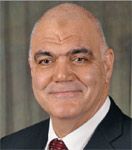- COVID-19
- Biosimilars
- Cataract Therapeutics
- DME
- Gene Therapy
- Workplace
- Ptosis
- Optic Relief
- Imaging
- Geographic Atrophy
- AMD
- Presbyopia
- Ocular Surface Disease
- Practice Management
- Pediatrics
- Surgery
- Therapeutics
- Optometry
- Retina
- Cataract
- Pharmacy
- IOL
- Dry Eye
- Understanding Antibiotic Resistance
- Refractive
- Cornea
- Glaucoma
- OCT
- Ocular Allergy
- Clinical Diagnosis
- Technology
Analyses favor use of laser
Results of a comparative study investigating capsulotomy features and ease of cataract extraction demonstrate clear benefits for using a femtosecond laser to create the capsular opening and fragment the nucleus.
Orlando, FL-Results of a comparative study investigating capsulotomy features and ease of cataract extraction demonstrate clear benefits for using a femtosecond laser to create the capsular opening and fragment the nucleus, said Roger F. Steinert, MD, during Refractive Surgery Subspecialty Day at the annual meeting of the International Society of Refractive Surgery/American Academy of Ophthalmology.

Statistically significant differences consistently favoring the femtosecond laser-assisted procedure were achieved in analyses of capsulotomy diameter and shape, as well as in two measures of ease of cataract extraction-the cumulative dissipated energy (CDE) value displayed by a phacoemulsification platform (Infiniti, Alcon Laboratories) and the number of active phacoemulsification tip maneuvers required to divide the lens into quadrants. Highly accurate centration of the femtosecond lasercreated capsulotomies was also demonstrated. "The data from this study show without question that use of the femtosecond laser significantly improves the accuracy of capsulotomy creation and the ease of lens extraction," said Dr. Steinert, Irving H. Leopold Professor and Chair of Ophthalmology, Gavin Herbert Eye Institute, University of California, Irvine.

Centration was investigated through analysis of still images from intraoperative video obtained with the femtosecond laser system and measured the deviation of the center of the capsular opening from the intended target, which for all eyes was the center of the dilated pupil.
"The femtosecond laser has a number of options for centering the capsulotomy," Dr. Steinert said. "Prior to docking, surgeons can configure the capsulotomy centration based on the pupil, limbus, scanned capsule, or some custom option, and then the system automatically centers the planned capsulotomy to the chosen target."

"The manual capsulotomies tended to be smaller than intended," Dr. Steinert said. "The difference between groups in mean deviation was highly statistically significant, with the laser providing a ten-fold improvement in accuracy and precision."
The analyses of shape showed the capsular openings created with the femtosecond laser approached perfect circularity. With 1.0 being the reference value for a perfect circle, the femtosecond laser group had a circularity index of 0.936 ± 0.038 compared with 0.774 ± 0.146 in the control. The difference between groups was again highly statistically significant.
Relative to the center of the dilated pupil, the center of the femtosecond laser-created capsulotomies had an average deviation of 77 ± 0.47 µm, demonstrating its accuracy and reproducibility.
